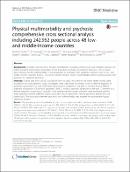| dc.description.abstract | : In people with psychosis, physical comorbidities, including cardiovascular and metabolic diseases, are
highly prevalent and leading contributors to the premature mortality encountered. However, little is known
about physical health multimorbidity in this population or in people with subclinical psychosis and in low- and
middle-income countries (LMICs). This study explores physical health multimorbidity patterns among people with
psychosis or subclinical psychosis.
Methods: Overall, data from 242,952 individuals from 48 LMICs, recruited via the World Health Survey, were
included in this cross-sectional study. Participants were subdivided into those (1) with a lifetime diagnosis of
psychosis (“psychosis”); (2) with more than one psychotic symptom in the past 12 months, but no lifetime
diagnosis of psychosis (“subclinical psychosis”); and (3) without psychotic symptoms in the past 12 months or a
lifetime diagnosis of psychosis (“controls”). Nine operationalized somatic disorders were examined: arthritis,
angina pectoris, asthma, diabetes, chronic back pain, visual impairment, hearing problems, edentulism, and
tuberculosis. The association between psychosis and multimorbidity was assessed by multivariable logistic
regression analysis.
Results: The prevalence of multimorbidity (i.e., two or more physical health conditions) was: controls = 11.4%
(95% CI, 11.0–11.8%); subclinical psychosis = 21.8% (95% CI, 20.6–23.0%), and psychosis = 36.0% (95% CI, 32.1–40.
2%) (P < 0.0001). After adjustment for age, sex, education, country-wise wealth, and country, subclinical psychosis
and psychosis were associated with 2.20 (95% CI, 2.02–2.39) and 4.05 (95% CI, 3.25–5.04) times higher odds for
multimorbidity. Moreover, multimorbidity was increased in subclinical and established psychosis in all age ranges
(18–44, 45–64, ≥ 65 years). However, multimorbidity was most evident in younger age groups, with people aged
18–44 years with psychosis at greatest odds of physical health multimorbidity (OR = 4.68; 95% CI, 3.46–6.32).(Continued from previous page)
Conclusions: This large multinational study demonstrates that physical health multimorbidity is increased across
the psychosis-spectrum. Most notably, the association between multimorbidity and psychosis was stronger
among younger adults, thus adding further impetus to the calls for the early intervention efforts to prevent the
burden of physical health comorbidity at later stages. Urgent public health interventions are necessary not only
for those with a psychosis diagnosis, but also for subclinical psychosis to address this considerable public health
problem. | en_US |

